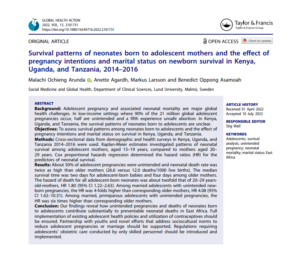
Background: Adolescent pregnancy and associated neonatal mortality are major global health challenges. In low-income settings where 90% of the 21 million global adolescent pregnancies occur, half are unintended and a fifth experience unsafe abortion. In Kenya, Uganda, and Tanzania, the survival patterns of neonates born to adolescents are unclear.
Objectives: To assess survival patterns among neonates born to adolescents and the effect of pregnancy intentions and marital status on survival in Kenya, Uganda, and Tanzania.
Methods: Cross-sectional data from demographic and health surveys in Kenya, Uganda, and Tanzania 2014–2016 were used. Kaplan-Meier estimates investigated patterns of neonatal survival among adolescent mothers, aged 15–19 years, compared to mothers aged 20–29 years. Cox proportional hazards regression determined the hazard ratios (HR) for the predictors of neonatal survival.
Results: About 50% of adolescent pregnancies were unintended and neonatal death rate was twice as high than older mothers (26.6 versus 12.0 deaths/1000 live births). The median survival time was two days for adolescent-born babies and four days among older mothers. The hazard of death for all adolescent-born neonates was about twofold that of 20–29 years old-mothers, HR 1.80 (95% CI 1.22–2.63). Among married adolescents with unintended newborn pregnancies, the HR was 4-folds higher than corresponding older mothers, HR 4.08 (95% CI 1.62–10.31). Among married, primiparous adolescents with unintended pregnancies, the HR was six times higher than corresponding older mothers.
Conclusion: Our findings reveal how unintended pregnancies and deaths of neonates born to adolescents contribute substantially to preventable neonatal deaths in East Africa. Full implementation of existing adolescent health policies and utilization of contraceptives should be ensured. Partnership with youths and novel efforts that address sociocultural norms to reduce adolescent pregnancies or marriage should be supported. Regulations requiring adolescents’ obstetric care conducted by only skilled personnel should be introduced and implemented.